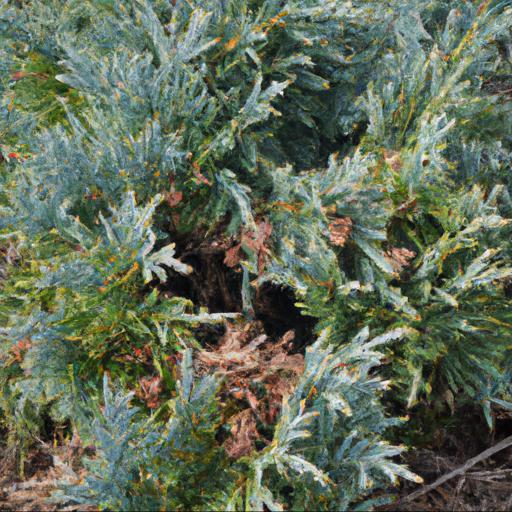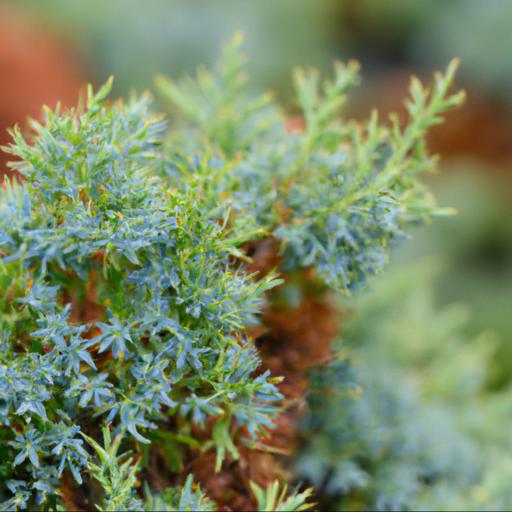Juniperus squamata ‘Blue Star’ is a stunning evergreen conifer that is native to the Himalayan mountains. It is an attractive shrub with its soft, silvery-blue foliage and distinctive, star-shaped needles.
This hardy shrub is perfect for adding texture and color to any landscape. It is low maintenance, drought tolerant, and can thrive in a variety of soil types. Its unique star-shaped needles make it an eye-catching addition to any garden.
With its vibrant blue foliage and hardy nature, Juniperus squamata ‘Blue Star’ is a great choice for any garden.
Benefits of growing juniperus squamata blue star

Juniperus squamata blue star is a popular evergreen conifer shrub, loved by gardeners around the world. Its blue-grey foliage and attractive growth pattern make it an ideal choice for a wide array of garden applications. Growing a Juniperus squamata blue star in your garden can provide many benefits that are sure to increase your outdoor landscape’s beauty and health.
The Juniperus squamata blue star is a popular choice due to its easy to care for and relatively low maintenance. With its striking delicate blue-grey foliage and silvery undersides, the shrub is sure to bring an exciting splash of color to any garden it graces.
Its flexible branches are also great for shaping, and the long-lasting foliage can be used to create a lovely contrast against grasses, other evergreen shrubs, and flowering plants. In addition to its attractive appearance, the Juniperus squamata blue star is also known for its hardiness and tolerance for a variety of conditions, making it a great addition to any garden regardless of climate. As a native of arid and semi-arid climates, the Juniperus squamata blue star enjoys dry and well-drained soil and can thrive in areas of partial sun or dappled shade.
Additionally, the shrub’s growth habit is also very slow, so it won’t need to be pruned or trimmed more often than once every few years. With its beautiful blue foliage and its low-maintenance traits, the Juniperus squamata blue star is the perfect choice for any gardener looking to upgrade their outdoor space.
When cared for appropriately, this shrub is sure to enhance your garden for many years to come.
Tips for planting and caring for juniperus squamata blue star

. Gardening beginners and experts alike know how beautiful and striking Juniperus squamata blue star can be in any garden. This species of juniper can produce striking bright blue foliage that really adds to the visual impact of your garden style.
For those looking to add this species of juniper to their garden, here are some tips on planting and caring for it. First off, it’s important to make sure the soil your Juniperus squamata blue star will be planted in is well-draining and slightly acidic.
Planting in a gravel-based soil and adding some organic material will help to ensure your juniper will have the best chance of thriving. It’s also important to provide it with enough space to grow. As this species of juniper can get quite large, be sure to give it plenty of room for its roots to extend and its branches and needles to reach out to the sun.
Once your Juniperus squamata blue star is planted, it’s important to keep an eye on its watering needs. This species of juniper is fairly resilient when it comes to weathering different conditions, but it is still important to keep it adequately hydrated.
Check your plant regularly and water it when the soil has dried out. Finally, to ensure you reap the full visual impact of your Juniperus squamata blue star, give it some occasional pruning.
Prune any dead branches or needles and check those in the center of the shrub. This will help to keep your juniper looking its best and maintain its conical shape. With these tips, your Juniperus squamata blue star is sure to thrive in your garden and add a stunning accent to your outdoor space.
With its bright blue foliage, this species of juniper can really set your garden apart, so be sure to give it the care and attention it deserves.
Common problems with juniperus squamata blue star

Juniperus squamata blue star is a beautiful low maintenance evergreen shrub many gardeners find themselves drawn to. Its tolerance of poor soil, extreme climates and its low water requirement makes it an ideal choice for a variety of garden designs.
The most common problem with Juniperus squamata blue star plants is poor drainage caused by heavy clay soils. Such soils can create problems to the plants root system, reducing its ability to take up the water and necessary nutrients it needs to thrive. In addition, another common problem associated with Juniperus squamata blue star is incorrect planting.
This could include planting in full sunlight or in soils with a pH too low or too high for the plants needs. Both of these scenarios can cause a wide range of problems for the plant including yellowing of foliage due to lack of nutrients, damage by frost, wilting and even plant death.
The final and most difficult common problem with Juniperus squamata blue star is pests or disease. This is an unpredictable problem that can require careful identification and will require the correct treatment fo the pest or disease. Common Juniperus squamata blue star pests include spider mites, juniper webgrowth, gall formed by Sawflies and Juniper tip moths.
If a plants is badly infected it can exasperate already existing problems such as malnutrition, stunted growth and leaf discolouration. Overall, Juniperus squamata blue star is a low maintenance and hardy shrub. It does faces issues similar to other plants, but is generally hardy and can survive a wide range of climates and soils.
If your Juniperus squamata blue star plant is showing signs of poor growth, it may be due to one of the most common problems mentioned. Taking the time to identify the issue and treat it quickly is essential for the plants long term health and survival.
Our video recommendation
Bottom Line
Juniperus squamata ‘Blue Star’ is an evergreen conifer with a pyramidal shape and soft, blue-green needles. It is a slow-growing conifer, reaching heights of up to 10 feet tall and 5 feet wide.
This hardy shrub is drought and deer resistant and can be used as a specimen or in a hedge. It is also a great choice for rock gardens and container gardens. Juniperus squamata ‘Blue Star’ is an easy-care plant that will bring texture and color to any landscape.
FAQ
What is the scientific name of Juniperus squamata blue star?
The scientific name of Juniperus squamata blue star is Juniperus squamata ‘Blue Star’.
What are the characteristics of Juniperus squamata blue star?
Juniperus squamata blue star is an evergreen coniferous shrub with a dense, conical shape and bright blue foliage. It has small, scale-like leaves that are blue-green in color and are arranged in four rows along the stems. The branches are flexible and the plant can reach up to 3 feet in height. It is drought tolerant and prefers full sun to partial shade.
Where is Juniperus squamata blue star native to?
Juniperus squamata blue star is native to the Himalayas and parts of Central Asia.
How does Juniperus squamata blue star respond to pruning?
Juniperus squamata blue star responds well to pruning and can be shaped into a variety of forms. Pruning should be done in late winter or early spring to promote new growth and maintain the desired shape.
What type of soil is best for Juniperus squamata blue star?
Well-draining, sandy soil with a pH of 6.0 to 8.0 is best for Juniperus squamata blue star.
How often should Juniperus squamata blue star be watered?
Juniperus squamata blue star should be watered once a week, allowing the soil to dry out between waterings.

